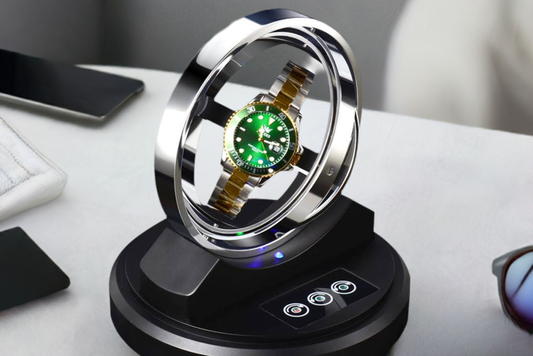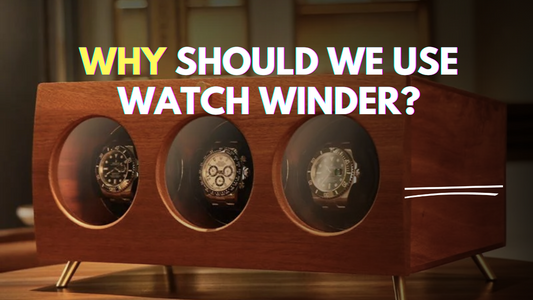Spotting a fake Rolex can be a daunting task, but with the right knowledge, you can become an expert in distinguishing the genuine from the imitation. This guide compiles the most effective methods to ensure you never fall for a counterfeit again.
Credit: YouTube Channel - Adrian Barker
How to Identify a Genuine Rolex Cyclops
When it comes to authenticating a Rolex, the Cyclops lens is a crucial feature to examine. The Cyclops, a date magnifier, is a distinctive characteristic of genuine Rolex watches. Here are the steps to follow to ensure the Cyclops lens on your Rolex is authentic:
Convex Lens
The first step in verifying the authenticity of the Cyclops lens is to check its shape and texture. A genuine Rolex Cyclops lens is convex in shape, meaning it is curved outward. This curvature should be smooth and even, without any noticeable bumps or irregularities. To perform this check, gently run your finger over the Cyclops lens. If it feels smooth and even, it is likely to be genuine. On the other hand, a fake Rolex may have a flat or concave lens, which can be a clear indication of its inauthenticity.
Date Magnification
The second step involves verifying the magnification power of the Cyclops lens. Genuine Rolex watches have a consistent magnification effect, typically around 2.5 times the original date size. To check this, look at the date through the Cyclops lens and compare it to the date without the lens. If the magnification is inconsistent or not around 2.5 times, it may be a sign of a counterfeit watch. Additionally, genuine Rolex Cyclops lenses tend to have a clear and sharp magnification, without any distortion or blurriness. If the magnified date appears fuzzy or unclear, it could be a fake.
The Heft of Authenticity: Weight and Feel
One of the most significant differences between a genuine Rolex and a fake lies in its weight. Authentic Rolex watches are crafted with high-quality materials, such as stainless steel, gold, or platinum, which contribute to their substantial weight. In contrast, counterfeit watches often employ cheaper materials to reduce production costs, resulting in a noticeably lighter feel. To illustrate this point, let us consider the weight of some popular Rolex models:
- The Rolex Submariner, a stainless steel diver's watch, weighs approximately 155 grams.
- The Rolex Datejust, a classic dress watch, tips the scales at around 120 grams.
- The Rolex Daytona, a chronograph watch, has a weight of roughly 140 grams.
Now, compare these weights to those of counterfeit Rolex watches. You will often find that the fake versions weigh significantly less, sometimes by as much as 20-30%. This disparity in weight is a clear indication of the inferior materials used in the production of counterfeit watches.
Case and Bracelet Finish
Another crucial aspect to examine is the finish of the case and bracelet. Genuine Rolex watches boast a solid, high-quality finish that exudes luxury and sophistication. The metal is meticulously polished and brushed to create a seamless blend of matte and glossy surfaces. In contrast, counterfeit watches often lack this attention to detail, resulting in a subpar finish that appears dull and uneven.
To spot a fake Rolex based on its case and bracelet finish, look for the following:
- Inspect the watch under different lighting conditions to highlight any imperfections in the finish.
- Check for uneven polishing or brushing patterns, which are common in counterfeit watches.
- Examine the edges and corners of the case and bracelet for any signs of rough machining or poor craftsmanship.
The Transparency of Quality: Sapphire Crystal Inspection
When it comes to evaluating the authenticity of a Rolex, one crucial aspect to examine is the sapphire crystal. Genuine Rolexes are renowned for their exceptional scratch resistance, which is a direct result of the high-quality materials used in their construction. The sapphire crystal, in particular, is a hallmark of Rolex's commitment to excellence.
Scratch Resistance
To test the scratch resistance of the crystal, gently run your fingernail or a soft cloth across the surface. A genuine Rolex sapphire crystal will exhibit remarkable resistance to scratches, maintaining its clarity and luster even under gentle pressure. This is due to the exceptional hardness of sapphire, which is second only to diamond in terms of scratch resistance. On the other hand, fake Rolexes often employ lower-quality materials, such as mineral glass or acrylic, which are more prone to scratches and damage.
Edge Quality
Another key feature to inspect is the edge quality of the crystal. Newer Rolex models typically boast laser-etched serial numbers beneath the crystal, which serves as a distinguishing characteristic of authenticity. To verify this, carefully lift the crystal and examine the edge for the presence of these laser-etched serial numbers. Genuine Rolexes will display crisp, precise engravings, whereas counterfeit models often lack this level of detail or exhibit poorly executed engravings.
Engraved Authenticity: Serial and Model Numbers
When it comes to spotting a fake Rolex, one crucial aspect to examine is the engraved authenticity of the serial and model numbers. Here, we will delve into the details of deep engravings and correct placement to help you distinguish a genuine Rolex from a counterfeit one.
Deep Engravings
A genuine Rolex watch features deep, clean engravings of its serial and model numbers. These engravings are typically crisp, sharp, and well-defined, indicating a high level of craftsmanship. On the other hand, fake Rolex watches often have shallow or sandy-looking engravings, which can be a significant red flag. The reason for this difference lies in the manufacturing process. Authentic Rolex watches undergo a rigorous engraving process that involves precise machinery and skilled labor, resulting in engravings that are both deep and clean.
Correct Placement
Another critical aspect to examine is the correct placement of the serial and model numbers on the watch. Genuine Rolex watches have these numbers engraved in specific locations, which can vary depending on the model. For example, the serial number is typically found between the lugs at the 6 o'clock position, while the model number is often engraved on the case back or between the lugs at the 12 o'clock position.
Fake Rolex watches often get this detail wrong, placing the numbers in incorrect locations or omitting them altogether. To verify the authenticity of a Rolex, ensure that the serial and model numbers are in their correct positions. If the numbers appear to be misplaced or are missing, it could be a sign of a counterfeit watch.
The Heart of the Watch: Movement and Functionality
When it comes to Rolex, the movement is indeed the heart of the watch. It's what sets these timepieces apart from their counterfeit counterparts. One of the most noticeable differences lies in the second hand's motion. A genuine Rolex features a smooth sweeping second hand, a hallmark of the brand's exceptional craftsmanship. This is due to Rolex's use of a mechanical movement, which allows for a seamless, sweeping motion. In contrast, fake Rolexes often exhibit a ticking motion, a clear indication of a quartz movement. This distinction is crucial, as it immediately sets genuine Rolexes apart from their imitations.
Winding Crown
Another critical aspect of a Rolex's movement and functionality is the winding crown. The winding crown is not only a functional component but also a testament to Rolex's attention to detail and commitment to quality. A genuine Rolex's winding crown operates smoothly, with a distinct "click" as it turns. This "click" is a result of the crown's intricate mechanism, which engages and disengages the watch's gears as it winds.
To test the winding crown, simply turn it clockwise while feeling for the smooth, incremental clicks. A genuine Rolex will exhibit a consistent, smooth operation, whereas a fake Rolex may have a rough or jerky motion. Additionally, the winding crown should be well-proportioned to the watch case, with a seamless integration that exudes quality and craftsmanship. Any inconsistencies or rough edges in the winding crown's operation or design can be a telltale sign of a counterfeit Rolex.
Precision in the Finishing: Crown and Logo Details
One of the most significant indicators of a genuine Rolex is the intricate details on the engraved crown. When examining the crown logo under magnification, look for sharp lines and precise engravings. Authentic Rolex crowns typically feature a three-dimensional crown logo with well-defined edges and a smooth, even finish. The logo should be symmetrical, with no signs of unevenness or roughness.
Font Consistency
Another crucial aspect to inspect is the font consistency on the dial. Genuine Rolex watches feature a specific font style that is consistent throughout the dial. Compare the font used on the dial with known authentic examples to ensure it matches. Pay attention to the spacing between letters, the shape of the numerals, and the overall aesthetic of the font.
For instance, the font used on a genuine Rolex Submariner (Ref. 126610) features a distinctive sans-serif style with a subtle curve to the numerals. The font is consistently applied throughout the dial, with no signs of unevenness or variation. Counterfeit watches often struggle to replicate this level of font consistency, resulting in a dial that appears cheap or amateurish.
Unique Traits of a Real Rolex
To identify an authentic Rolex, it is crucial to examine specific features that are unique to the brand. Here are some key aspects to look for:
Helium Escape Valve
One of the distinguishing features of a genuine Rolex is the helium escape valve, particularly on models like the Sea-Dweller. This valve is designed to release helium gas that can accumulate inside the watch during deep-sea diving. To verify its authenticity, ensure that the valve is correctly implemented and not just a superficial addition. A genuine helium escape valve will have a subtle yet distinct design, which can be recognized by its functional and precise mechanism.
Bracelet Links
Another important aspect to inspect is the quality and mechanism of the bracelet links. Genuine Rolex watches often feature micro-adjustment mechanisms that allow for precise adjustments to the bracelet length. These micro-adjustments are typically found on the clasp of the bracelet and are designed to provide a comfortable and secure fit. In contrast, counterfeit watches often simplify these mechanisms or omit them altogether.
Tips for Secure Purchases
When purchasing a Rolex, it is essential to buy from authorized dealers or reputable pre-owned watch sellers. These dealers have been vetted by Rolex and are authorized to sell their watches. You can find a list of authorized Rolex dealers on the official Rolex website. Buying from an authorized dealer ensures that you are getting a genuine Rolex watch, and you will also receive the necessary documentation and warranty.
Certification and Papers
Verifying the watch's authenticity with accompanying documentation and certificates is crucial. When buying a Rolex, you should receive a series of documents, including the warranty card, which is stamped and signed by the authorized dealer. The warranty card should have a unique serial number that matches the number on the watch. Additionally, you should receive a certificate of authenticity from Rolex, which is a detailed document that verifies the watch's authenticity. This certificate includes details such as the watch's model number, case number, and movement number. Furthermore, the watch should come with a manual, a box, and other accessories, all of which should be stamped with the Rolex logo.
Conclusion
Mastering the art of spotting a fake Rolex involves a keen eye for detail and a good understanding of the brand's meticulous craftsmanship. By following these steps, you can protect your investment and ensure that your Rolex is as timeless as the brand's reputation. Stay vigilant and never compromise on quality.
We hope this comprehensive guide has provided you with the knowledge and tools necessary to confidently identify genuine Rolex watches. Remember, if you have any doubts about the authenticity of a Rolex, it is always best to consult with a trusted expert or authorized dealer.
Do you have any personal experiences or tips for spotting fake Rolexes? Share your thoughts and insights in the comments below, and help others navigate the world of luxury watches with confidence.




